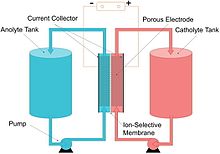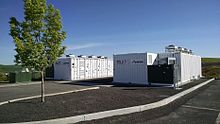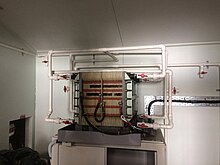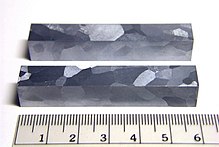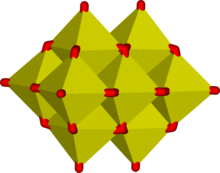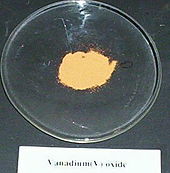From Wikipedia, the free encyclopedia
Vanadium, 23V
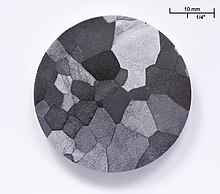 |
| Vanadium |
|---|
| Pronunciation | (və-NAY-dee-əm) |
|---|
| Appearance | blue-silver-grey metal |
|---|
| Standard atomic weight Ar, std(V) | 50.9415(1) |
|---|
| Vanadium in the periodic table |
|---|
|
|
| Atomic number (Z) | 23 |
|---|
| Group | group 5 |
|---|
| Period | period 4 |
|---|
| Block | d-block |
|---|
| Element category | transition metal |
|---|
| Electron configuration | [Ar] 3d3 4s2 |
|---|
Electrons per shell
| 2, 8, 11, 2 |
|---|
| Physical properties |
|---|
| Phase at STP | solid |
|---|
| Melting point | 2183 K (1910 °C, 3470 °F) |
|---|
| Boiling point | 3680 K (3407 °C, 6165 °F) |
|---|
| Density (near r.t.) | 6.0 g/cm3 |
|---|
| when liquid (at m.p.) | 5.5 g/cm3 |
|---|
| Heat of fusion | 21.5 kJ/mol |
|---|
| Heat of vaporization | 444 kJ/mol |
|---|
| Molar heat capacity | 24.89 J/(mol·K) |
|---|
Vapor pressure
| P (Pa)
|
1
|
10
|
100
|
1 k
|
10 k
|
100 k
|
| at T (K)
|
2101
|
2289
|
2523
|
2814
|
3187
|
3679
|
|
| Atomic properties |
|---|
| Oxidation states | −3, −1, +1, +2, +3, +4, +5 (an amphoteric oxide) |
|---|
| Electronegativity | Pauling scale: 1.63 |
|---|
| Ionization energies |
- 1st: 650.9 kJ/mol
- 2nd: 1414 kJ/mol
- 3rd: 2830 kJ/mol
- (more)
|
|---|
| Atomic radius | empirical: 134 pm |
|---|
| Covalent radius | 153±8 pm |
|---|
|
Spectral lines of vanadium |
| Other properties |
|---|
| Natural occurrence | primordial |
|---|
| Crystal structure | body-centered cubic (bcc)
|
|---|
| Speed of sound thin rod | 4560 m/s (at 20 °C) |
|---|
| Thermal expansion | 8.4 µm/(m·K) (at 25 °C) |
|---|
| Thermal conductivity | 30.7 W/(m·K) |
|---|
| Electrical resistivity | 197 nΩ·m (at 20 °C) |
|---|
| Magnetic ordering | paramagnetic |
|---|
| Magnetic susceptibility | +255.0·10−6 cm3/mol (298 K) |
|---|
| Young's modulus | 128 GPa |
|---|
| Shear modulus | 47 GPa |
|---|
| Bulk modulus | 160 GPa |
|---|
| Poisson ratio | 0.37 |
|---|
| Mohs hardness | 6.7 |
|---|
| Vickers hardness | 628–640 MPa |
|---|
| Brinell hardness | 600–742 MPa |
|---|
| CAS Number | 7440-62-2 |
|---|
| History |
|---|
| Discovery | Andrés Manuel del Río (1801) |
|---|
| First isolation | Nils Gabriel Sefström (1830) |
|---|
| Named by | Nils Gabriel Sefström (1830) |
|---|
| Main isotopes of vanadium |
|---|
|
|
Vanadium is a
chemical element with the
symbol V and
atomic number 23. It is a hard, silvery-grey,
ductile,
malleable transition metal. The elemental metal is rarely found in nature, but once isolated artificially, the formation of an
oxide layer (
passivation) somewhat stabilizes the free metal against further
oxidation.
Andrés Manuel del Río discovered compounds of vanadium in 1801 in
Mexico by analyzing a new
lead-bearing mineral he called "brown lead", and presumed its qualities were due to the presence of a new element, which he named
erythronium (derived from "
ἐρυθρόν",
greek word for "red") since upon heating most of the
salts turned red. Four years later, he was (erroneously) convinced by other scientists that erythronium was identical to
chromium.
Chlorides of vanadium were generated in 1830 by
Nils Gabriel Sefström
who thereby proved that a new element was involved, which he named
"vanadium" after the Scandinavian goddess of beauty and fertility,
Vanadís (
Freyja). Both names were attributed to the wide range of colors found in vanadium compounds. Del Rio's lead mineral was later renamed
vanadinite for its vanadium content. In 1867
Henry Enfield Roscoe obtained the pure element.
Vanadium occurs naturally in about 65
minerals and in
fossil fuel deposits. It is produced in
China and
Russia from steel smelter
slag. Other countries produce it either from magnetite directly, flue dust of heavy oil, or as a byproduct of
uranium mining. It is mainly used to produce specialty
steel alloys such as
high-speed tool steels. The most important industrial vanadium compound,
vanadium pentoxide, is used as a catalyst for the production of
sulfuric acid. The
vanadium redox battery for energy storage may be an important application in the future.
Large amounts of vanadium
ions are found in a few organisms, possibly as a
toxin.
The oxide and some other salts of vanadium have moderate toxicity.
Particularly in the ocean, vanadium is used by some life forms as an
active center of
enzymes, such as the
vanadium bromoperoxidase of some ocean
algae.
History
Vanadium was
discovered by
Andrés Manuel del Río, a Spanish-Mexican mineralogist, in 1801. Del Río extracted the element from a sample of Mexican "brown lead" ore, later named
vanadinite. He found that its salts exhibit a wide variety of colors, and as a result he named the element
panchromium (Greek: παγχρώμιο "all colors"). Later, Del Río renamed the element
erythronium (Greek: ερυθρός "red") because most of the salts turned red upon heating. In 1805, French chemist
Hippolyte Victor Collet-Descotils, backed by del Río's friend Baron
Alexander von Humboldt, incorrectly declared that del Río's new element was only an impure sample of
chromium. Del Río accepted Collet-Descotils' statement and retracted his claim.
In 1831, Swedish chemist
Nils Gabriel Sefström rediscovered the element in a new oxide he found while working with
iron ores. Later that year,
Friedrich Wöhler confirmed del Río's earlier work. Sefström chose a name beginning with V, which had not yet been assigned to any element. He called the element
vanadium after
Old Norse Vanadís (another name for the
Norse Vanr goddess
Freyja, whose attributes include beauty and fertility), because of the many beautifully colored
chemical compounds it produces. In 1831, the geologist
George William Featherstonhaugh suggested that vanadium should be renamed "
rionium" after del Río, but this suggestion was not followed.
The first large-scale industrial use of vanadium was in the
steel alloy chassis of the
Ford Model T, inspired by French race cars. Vanadium steel allowed reduced weight while increasing
tensile strength (ca. 1905).
[8] For the first decade of the 20
th century, most vanadium ore was mined by
American Vanadium Company from the
Minas Ragra in Peru. Later the demand for uranium rose, leading to increased mining of that metal's ores. One major uranium ore was
carnotite,
which also contains vanadium. Thus, vanadium became available as a
by-product of uranium production. Eventually uranium mining began to
supply a large share of the demand for vanadium.
Characteristics
High-purity (99.95%) vanadium cuboids, ebeam remelted and macro-etched
Isotopes
Naturally occurring vanadium is composed of one stable
isotope,
51V, and one radioactive isotope,
50V. The latter has a
half-life of 1.5×10
17 years and a natural abundance of 0.25%.
51V has a
nuclear spin of
7⁄2, which is useful for
NMR spectroscopy. Twenty-four artificial
radioisotopes have been characterized, ranging in
mass number from 40 to 65. The most stable of these isotopes are
49V with a half-life of 330 days, and
48V with a half-life of 16.0 days. The remaining
radioactive isotopes have half-lives shorter than an hour, most below 10 seconds. At least four isotopes have
metastable excited states.
Electron capture is the main
decay mode for isotopes lighter than
51V. For the heavier ones, the most common mode is
beta decay. The electron capture reactions lead to the formation of element 22 (
titanium) isotopes, while beta decay leads to element 24 (
chromium) isotopes.
Chemistry
From left: [V(H2O)6]2+ (lilac), [V(H2O)6]3+ (green), [VO(H2O)5]2+ (blue) and [VO(H2O)5]3+ (yellow).
The chemistry of vanadium is noteworthy for the accessibility of the four adjacent
oxidation states 2–5. In
aqueous solution, vanadium forms
metal aquo complexes of which the colours are lilac [V(H
2O)
6]
2+, green [V(H
2O)
6]
3+, blue [VO(H
2O)
5]
2+, yellow VO
3−.
Vanadium(II) compounds are reducing agents, and vanadium(V) compounds
are oxidizing agents. Vanadium(IV) compounds often exist as
vanadyl derivatives, which contain the VO
2+ center.
Ammonium vanadate(V) (NH
4VO
3) can be successively reduced with elemental
zinc
to obtain the different colors of vanadium in these four oxidation
states. Lower oxidation states occur in compounds such as V(CO)
6,
[V(CO)
6]− and substituted derivatives.
The most commercially important compound is
vanadium pentoxide. It is used as a catalyst for the production of sulfuric acid. This compound oxidizes
sulfur dioxide (
SO
2) to the
trioxide (
SO
3). In this
redox reaction, sulfur is oxidized from +4 to +6, and vanadium is reduced from +5 to +4:
- V2O5 + SO2 → 2 VO2 + SO3
The catalyst is regenerated by oxidation with air:
- 4 VO2 + O2 → 2 V2O5
The
vanadium redox battery
utilizes all four oxidation states: one electrode uses the +5/+4 couple
and the other uses the +3/+2 couple. Conversion of these oxidation
states is illustrated by the reduction of a strongly acidic solution of a
vanadium(V) compound with zinc dust or amalgam. The initial yellow
color characteristic of the pervanadyl ion [VO
2(H
2O)
4]
+ is replaced by the blue color of [VO(H
2O)
5]
2+, followed by the green color of [V(H
2O)
6]
3+ and then the violet color of [V(H
2O)
6]
2+.
Oxyanions
In aqueous solution, vanadium(V) forms an extensive family of
oxyanions. The interrelationships in this family are described by the
predominance diagram, which shows at least 11 species, depending on pH and concentration. The tetrahedral orthovanadate ion,
VO3−
4,
is the principal species present at pH 12-14. Similar in size and
charge to phosphorus(V), vanadium(V) also parallels its chemistry and
crystallography.
Orthovanadate V
O3−
4 is used in
protein crystallography to study the
biochemistry of phosphate. The tetrathiovanadate [VS
4]
3− is analogous to the orthovanadate ion.
At lower pH values, the monomer [HVO
4]
2− and dimer [V
2O
7]
− are formed, with the monomer predominant at vanadium concentration of less than c. 10
−2M
(pV > 2, where pV is equal to the minus value of the logarithm of
the total vanadium concentration/M). The formation of the divanadate ion
is analogous to the formation of the
dichromate ion. As the pH is reduced, further protonation and condensation to
polyvanadates occur: at pH 4-6 [H
2VO
4]
− is predominant at pV greater than ca. 4, while at higher concentrations trimers and tetramers are formed. Between pH 2-4
decavanadate predominates, its formation from orthovanadate is represented by this condensation reaction:
- 10 [VO4]3− + 24 H+ → [V10O28]6− + 12 H2O
In decavanadate, each V(V) center is surrounded by six oxide
ligands. Vanadic acid, H
3VO
4 exists only at very low concentrations because protonation of the tetrahedral species [H
2VO
4]
− results in the preferential formation of the octahedral [VO
2(H
2O)
4]
+ species. In strongly acidic solutions, pH<2 .="" sub="">2
(H
2O)
4]
+ is the predominant species, while the oxide V
2O
5 precipitates from solution at high concentrations. The oxide is formally the
acid anhydride of vanadic acid. The structures of many
vanadate compounds have been determined by X-ray crystallography.
The
Pourbaix diagram for vanadium in water, which shows the
redox potentials between various vanadium species in different oxidation states, is also complex.
Vanadium(V) forms various peroxo complexes, most notably in the active site of the vanadium-containing
bromoperoxidase enzymes. The species VO(O)
2(H
2O)
4+
is stable in acidic solutions. In alkaline solutions, species with 2, 3
and 4 peroxide groups are known; the last forms violet salts with the
formula M
3V(O
2)
4 nH
2O (M= Li, Na, etc.), in which the vanadium has an 8-coordinate dodecahedral structure.
Halide derivatives
Twelve binary
halides, compounds with the formula VX
n (n=2..5), are known. VI
4, VCl
5, VBr
5, and VI
5 do not exist or are extremely unstable. In combination with other reagents,
VCl4 is used as a catalyst for polymerization of
dienes. Like all binary halides, those of vanadium are
Lewis acidic, especially those of V(IV) and V(V). Many of the halides form octahedral complexes with the formula VX
nL
6−n (X= halide; L= other ligand).
Many vanadium
oxyhalides (formula VO
mX
n) are known. The oxytrichloride and oxytrifluoride (
VOCl3 and
VOF3) are the most widely studied. Akin to POCl
3, they are volatile, adopt tetrahedral structures in the gas phase, and are Lewis acidic.
Coordination compounds

Complexes of vanadium(II) and (III) are relatively exchange inert and
reducing. Those of V(IV) and V(V) are oxidants. Vanadium ion is rather
large and some complexes achieve coordination numbers greater than 6, as
is the case in [V(CN)
7]
4−. Oxovanadium(V) also
forms 7 coordinate coordination complexes with tetradentate ligands and
peroxides and these complexes are used for oxidative brominations and
thioether oxidations. The coordination chemistry of V
4+ is dominated by the
vanadyl center, VO
2+, which binds four other ligands strongly and one weakly (the one trans to the vanadyl center). An example is
vanadyl acetylacetonate (V(O)(O
2C
5H
7)
2).
In this complex, the vanadium is 5-coordinate, square pyramidal,
meaning that a sixth ligand, such as pyridine, may be attached, though
the
association constant of this process is small. Many 5-coordinate vanadyl complexes have a trigonal bipyramidal geometry, such as VOCl
2(NMe
3)
2. The coordination chemistry of V
5+
is dominated by the relatively stable dioxovanadium coordination
complexes which are often formed by aerial oxidation of the vanadium(IV)
precursors indicating the stability of the +5 oxidation state and ease
of interconversion between the +4 and +5 states.
Organometallic compounds
Organometallic chemistry of vanadium is well developed, although it has mainly only academic significance.
Vanadocene dichloride is a versatile starting reagent and even finds some applications in organic chemistry.
Vanadium carbonyl, V(CO)
6, is a rare example of a paramagnetic
metal carbonyl. Reduction yields V
(CO)−
6 (
isoelectronic with
Cr(CO)6), which may be further reduced with sodium in liquid ammonia to yield V
(CO)3−
5 (isoelectronic with Fe(CO)
5).
Occurrence
Universe
Earth's crust
Vanadium is the 20th most abundant element in the earth's crust; metallic vanadium is rare in nature (known as the mineral vanadium,
native vanadium), but vanadium compounds occur naturally in about 65 different
minerals.
At the beginning of the 20th century a large deposit of vanadium ore was discovered. For several years this
patrónite (VS
4) deposit was a economically significant source for vanadium ore. With the production of radium in the 1910s and 1920s from
carnotite (
K2(UO2)2(VO4)2·3H2O) vanadium became available as a side product of radium and uranium production.
Vanadinite (
Pb5(VO4)3Cl)
and other vanadium bearing minerals are only mined in exceptional
cases. With the rising demand, much of the world's vanadium production
is now sourced from vanadium-bearing
magnetite found in
ultramafic gabbro bodies. If this
titanomagnetite is used to produce iron, most of the vanadium goes to the
slag, and is extracted from it.
Vanadium is mined mostly in
South Africa, north-western
China, and eastern
Russia. In 2013 these three countries mined more than 97% of the 79,000
tonnes of produced vanadium.
Vanadium is also present in
bauxite and in deposits of
crude oil,
coal,
oil shale, and
tar sands.
In crude oil, concentrations up to 1200 ppm have been reported. When
such oil products are burned, traces of vanadium may cause
corrosion in engines and boilers. An estimated 110,000 tonnes of vanadium per year are released into the atmosphere by burning fossil fuels.
Water
Production
Vacuum sublimed vanadium dendritic crystals (99.9%)
Crystal-bar vanadium, showing different textures and surface oxidation; 99.95%-pure cube for comparison
Vanadium metal is obtained by a multistep process that begins with roasting crushed ore with
NaCl or
Na2CO3 at about 850 °C to give
sodium metavanadate (NaVO
3). An aqueous extract of this solid is acidified to produce "red cake", a polyvanadate salt, which is reduced with
calcium metal. As an alternative for small-scale production, vanadium pentoxide is reduced with
hydrogen or
magnesium. Many other methods are also used, in all of which vanadium is produced as a
byproduct of other processes. Purification of vanadium is possible by the
crystal bar process developed by
Anton Eduard van Arkel and
Jan Hendrik de Boer in 1925. It involves the formation of the metal iodide, in this example
vanadium(III) iodide, and the subsequent decomposition to yield pure metal:
- 2 V + 3 I2 ⇌ 2 VI3
Most vanadium is used as a
steel alloy called
ferrovanadium.
Ferrovanadium is produced directly by reducing a mixture of vanadium
oxide, iron oxides and iron in an electric furnace. The vanadium ends up
in
pig iron produced from vanadium-bearing magnetite. Depending on the ore used, the slag contains up to 25% of vanadium.
Applications
Tool made from vanadium steel
Alloys
Approximately 85% of the vanadium produced is used as
ferrovanadium or as a
steel additive.
The considerable increase of strength in steel containing small amounts
of vanadium was discovered in the early 20th century. Vanadium forms
stable nitrides and carbides, resulting in a significant increase in the
strength of steel. From that time on, vanadium steel was used for applications in
axles, bicycle frames,
crankshafts,
gears, and other critical components. There are two groups of vanadium
steel alloys. Vanadium high-carbon steel alloys contain 0.15% to 0.25%
vanadium, and
high-speed tool steels (HSS) have a vanadium content of 1% to 5%. For high-speed tool steels, a hardness above
HRC 60 can be achieved. HSS steel is used in
surgical instruments and
tools.
Powder-metallurgic
alloys contain up to 18% percent vanadium. The high content of vanadium
carbides in those alloys increases wear resistance significantly. One
application for those alloys is tools and knives.
Vanadium stabilizes the beta form of titanium and increases the strength and temperature stability of titanium. Mixed with
aluminium in
titanium alloys, it is used in
jet engines, high-speed airframes and
dental implants. The most common alloy for seamless tubing is
Titanium 3/2.5 containing 2.5% vanadium, the titanium alloy of choice in the aerospace, defense, and bicycle industries. Another common alloy, primarily produced in sheets, is
Titanium 6AL-4V, a titanium alloy with 6% aluminium and 4% vanadium.
Several vanadium alloys show superconducting behavior. The first
A15 phase superconductor was a vanadium compound, V
3Si, which was discovered in 1952.
Vanadium-gallium tape is used in
superconducting magnets (17.5
teslas or 175,000
gauss). The structure of the superconducting A15 phase of V
3Ga is similar to that of the more common
Nb3Sn and
Nb3Ti.
It has been proposed that a small amount, 40 to 270 ppm, of vanadium in
Wootz steel and
Damascus steel significantly improved the strength of the product, though the source of the vanadium is unclear.
Other uses
Vanadium compounds are used extensively as catalysts; for example, the most common oxide of vanadium,
vanadium pentoxide V
2O
5, is used as a
catalyst in manufacturing sulfuric acid by the
contact process and as an oxidizer in
maleic anhydride production. Vanadium pentoxide is used in
ceramics.
Vanadium is an important component of mixed metal oxide catalysts used
in the oxidation of propane and propylene to acrolein, acrylic acid or
the ammoxidation of propylene to acrylonitrile.
In service, the oxidation state of vanadium changes dynamically and
reversibly with the oxygen and the steam content of the reacting feed
mixture. Another oxide of vanadium,
vanadium dioxide VO
2, is used in the production of glass coatings, which blocks
infrared radiation (and not visible light) at a specific temperature. Vanadium oxide can be used to induce color centers in
corundum to create simulated
alexandrite jewelry, although alexandrite in nature is a
chrysoberyl.
The
Vanadium redox battery, a type of
flow battery, is an electrochemical cell consisting of aqueous vanadium ions in different oxidation states.
Batteries of the type were first proposed in the 1930s and developed
commercially from the 1980s onwards. Cells use +5 and +2 formal
oxidization state ions.
Vanadium redox batteries are used commercially for
grid energy storage.
Proposed
Biological role
Vanadium is more important in marine environments than terrestrial.
Vanadoenzymes
- R-H + Br− + H2O2 → R-Br + H2O + OH−
Vanadium accumulation in tunicates and ascidians
Vanadium is essential to
ascidians and
tunicates, where it is stored in the highly acidified
vacuoles of certain blood cell types, designated "vanadocytes".
Vanabins
(vanadium binding proteins) have been identified in the cytoplasm of
such cells. The concentration of vanadium in the blood of ascidians is
as much as ten million times higher than the surrounding seawater, which normally contains 1 to 2 µg/l.
The function of this vanadium concentration system and these
vanadium-bearing proteins is still unknown, but the vanadocytes are
later deposited just under the outer surface of the tunic where they may
deter
predation.
Fungi
Amanita muscaria and related species of macrofungi accumulate vanadium (up to 500 mg/kg in dry weight). Vanadium is present in the
coordination complex amavadin in fungal fruit-bodies. The biological importance of the accumulation is unknown. Toxic or
peroxidase enzyme functions have been suggested.
Mammals
Deficiencies in vanadium result in reduced growth in rats.
The U.S. Institute of Medicine has not confirmed that vanadium is an
essential nutrient for humans, so neither a Recommended Dietary Intake
nor an Adequate Intake have been established. Dietary intake is
estimated at 6 to 18 µg/day, with less than 5% absorbed. The
Tolerable Upper Intake Level (UL) of dietary vanadium, beyond which adverse effects may occur, is set at 1.8 mg/day.
Research
Vanadyl
sulfate as a dietary supplement has been researched as a means of
increasing insulin sensitivity or otherwise improving glycemic control
in people who are diabetic. Some of the trials had significant treatment
effects, but were deemed as being of poor study quality. The amounts of
vanadium used in these trials (30 to 150 mg) far exceeded the safe
upper limit.
The conclusion of the systemic review was "There is no rigorous
evidence that oral vanadium supplementation improves glycaemic control
in type 2 diabetes. The routine use of vanadium for this purpose cannot
be recommended."
Safety
All vanadium compounds should be considered toxic. Tetravalent
VOSO4 has been reported to be at least 5 times more toxic than trivalent V
2O
3. The
Occupational Safety and Health Administration (OSHA) has set an exposure limit of 0.05 mg/m
3 for vanadium pentoxide dust and 0.1 mg/m
3 for vanadium pentoxide fumes in workplace air for an 8-hour workday, 40-hour work week. The
National Institute for Occupational Safety and Health (NIOSH) has recommended that 35 mg/m
3
of vanadium be considered immediately dangerous to life and health,
that is, likely to cause permanent health problems or death.
Vanadium compounds are poorly absorbed through the
gastrointestinal system. Inhalation of vanadium and vanadium compounds
results primarily in adverse effects on the respiratory system. Quantitative data are, however, insufficient to derive a subchronic or
chronic inhalation reference dose. Other effects have been reported
after oral or inhalation exposures on blood parameters, liver, neurological development, and other organs in rats.
There is little evidence that vanadium or vanadium compounds are reproductive toxins or
teratogens. Vanadium pentoxide was reported to be carcinogenic in male rats and in male and female mice by inhalation in an NTP study, although the interpretation of the results has recently been disputed. The carcinogenicity of vanadium has not been determined by the
United States Environmental Protection Agency.
Vanadium traces in
diesel fuels are the main fuel component in
high temperature corrosion. During combustion, vanadium oxidizes and reacts with sodium and sulfur, yielding
vanadate compounds with melting points as low as 530 °C, which attack the
passivation layer on steel and render it susceptible to corrosion. The solid vanadium compounds also abrade engine components.
